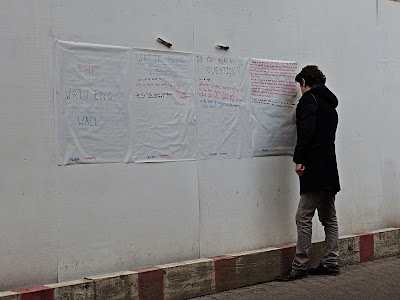Someone had the bright idea of pinning up some sheets of paper and supplying marker pens for passers-by to record their thoughts and questions. As this is in the midst of the university area of Cambridge you might expect more profound questions than "Where's the nearest pub?" though I'm afraid you'd be wrong. In fairness I got fed up of waiting for the young man in the picture to finish his lengthy discourse and wandered off to find more permanent words on walls.
A little way along the street from the first picture stands St Botolph's Church. It's an interesting building and someday I'll invest some time to photographing it properly, but for now I'll just show you the little plaque above. This is one of the ways that social care was funded in days gone by. I'm surprised to see such a large sum being bequeathed by a bricklayer as it would be like saving £97,000 today (though such calculations are fraught with difficulty). It's also unusual to see such a donation commemorated in this way.
"Near this place lies the body of Francis Squire who departed this life ye 29th of december 1732 in ye 65 year of his age" What caught my attention here was the rather gruesome skull which, although not to modern taste, was quite a common symbol on old gravestones.
I often find myself reading the names on war memorials and wondering at the senseless loss of life recorded on them, but this is the first one that's ever made me smile - whatever possessed anyone to name their son W.O.R.KING ?????
Graffiti in churches is a lot more abundant than you might think; sometimes the builders left their mark but mostly it was just local people making a bid to be remembered for eternity. Or at least for 216 years and counting.
Another odd scratching inside a church. It seems to be a representation of a warrior or knight of some kind, possibly St George. Nobody seems to know much about this one except that it's very old.
And finally I can never resist a bit of grandiloquent Victorian prose:
COUNTY OF HERTFORD
TAKE NOTICE THAT THIS BRIDGE IS
INSUFFICIENT TO CARRY WEIGHTS BEYOND THE
ORDINARY TRAFFIC OF THE DISTRICT,AND THAT OWNERS
AND ALL OTHER PERSONS IN CHARGE OF LOCOMOTIVES,AND
ALL OTHER PONDEROUS CARRIAGES, ARE WARNED
AGAINST ATTEMPTING THE PASSAGE OF THE BRIDGE.
___________________
BY ORDER OF THE COUNTY COUNCIL
C.E.LONGMORE,
CLERK OF THE COUNTY COUNCIL.
HERTFORD.
23RD OCTOBER, 1899.
Regular readers might remember from the post about steam traction engines that the largest examples of such vehicles were known as "road locomotives" and these huge machines (along with other ponderous carriages) were what posed a danger to the structure of the bridge. It must have been a real problem at the time as roads were simply not designed for such large weights. Whatever one thinks of the ponderous prose it seems to have done the trick - the bridge is still standing.
Take care.








The skull on the gravestone looks so familiar - I see it all the time in my neck of the woods. It's a very common carving on older headstones here in New England, along with a stylized Greek urn and willow, which I'm guessing you have there, too. I suppose the styles traveled cross the Atlantic with the colonists.
ReplyDeleteInteresting collection! It's amazing what you find when you go out hunting for it.
ReplyDeleteNo time to write a long comment... I have to go polish my ponderous carriage.
ReplyDeleteI'm guessing the artist of the St. George sketch to be about 6-10 years old (boy, of course) - some things never change. I'm putting W.O.R. King down to a couple of very sleep deprived parents.
ReplyDeleteI love all these old signs! What a fun post.
ReplyDeleteNow the old graffiti is fascinating, in many ways much more revealing than the proper inscriptions
ReplyDeletethe more things change the more they remain the same, eh?
ReplyDeleteI'll bet the old graffiti was more interesting than what was being recorded on the paper. I wonder how long it took for generous John Brewer's funds to run out.
ReplyDeleteI've wondered about the purpose of the skulls on the gravestones. To ward off evil spirits or something? They seem rather gruesome and pagan to me and it seems like they must have had a purpose.
Not evil spirits, much more practical. To remind the viewer to shape up! Death's a-comin'.
DeleteI think it's fascinating that graffiti is not a modern phenomenon...not at all!
ReplyDeleteI'm still wondering what was written in that first picture....
ReplyDeleteVery interesting and a fine way of presenting local history mixed with a suitable amount of humour.
ReplyDeleteYour pictures tell stories...that´s difficult and I like it.
ReplyDeleteInspiring
Annette
You've made me laugh yet again. W.O.R King! I came across someone by the name of Heidi High once. (That will doubtless only mean something to Brits of a certain vintage.)
ReplyDelete